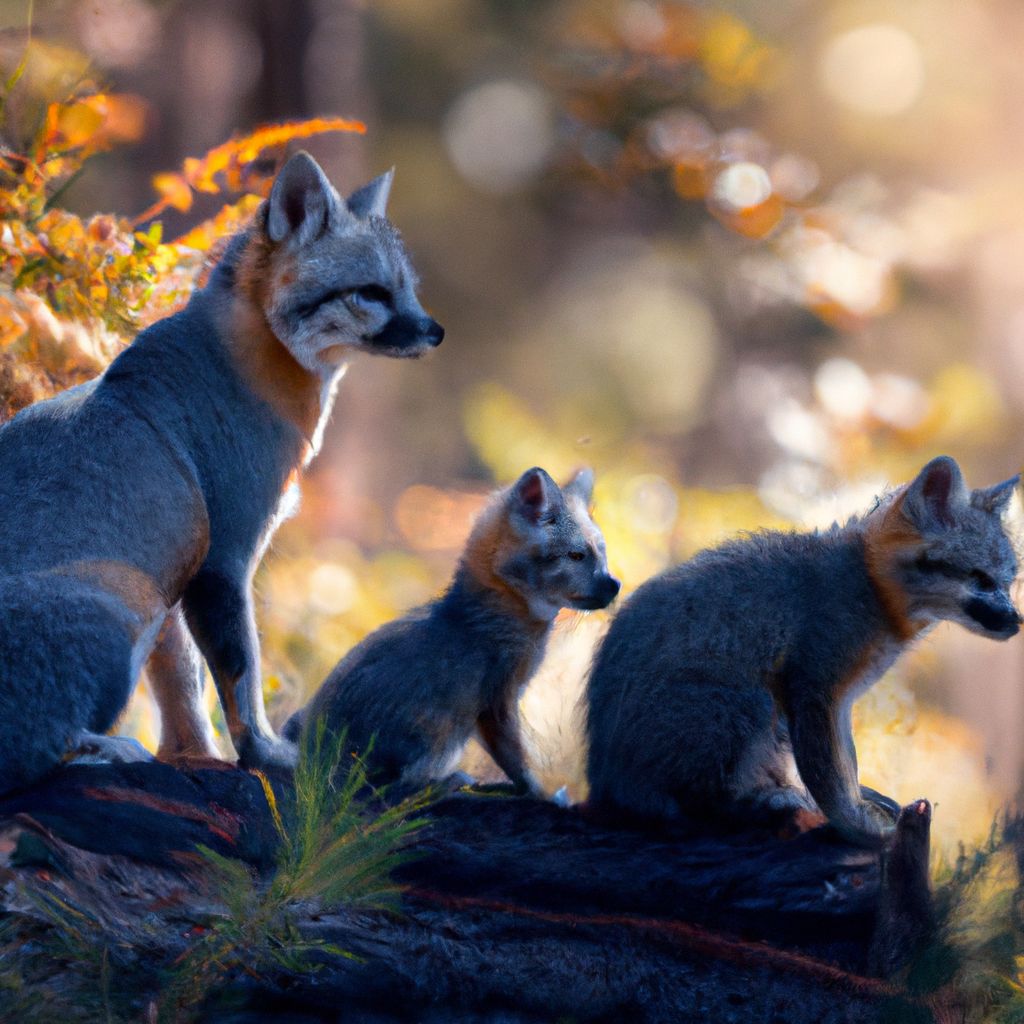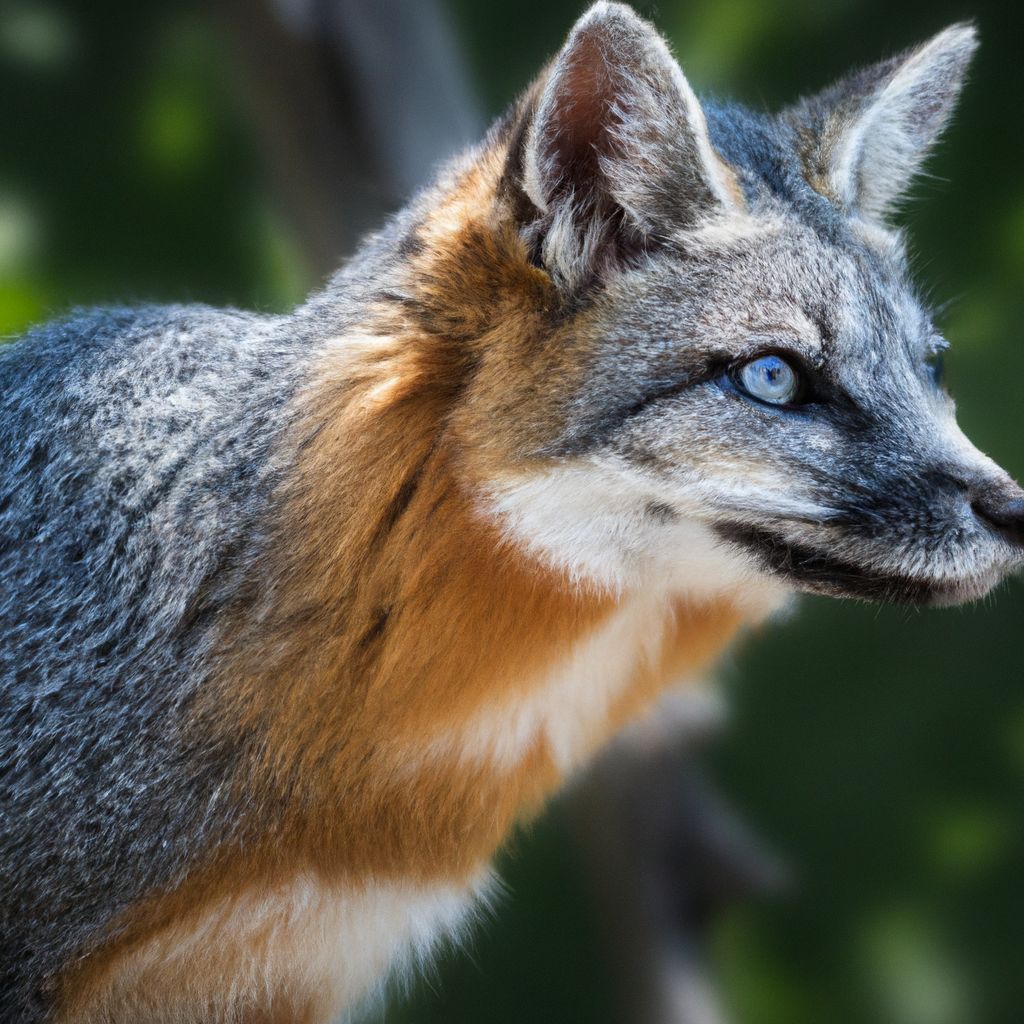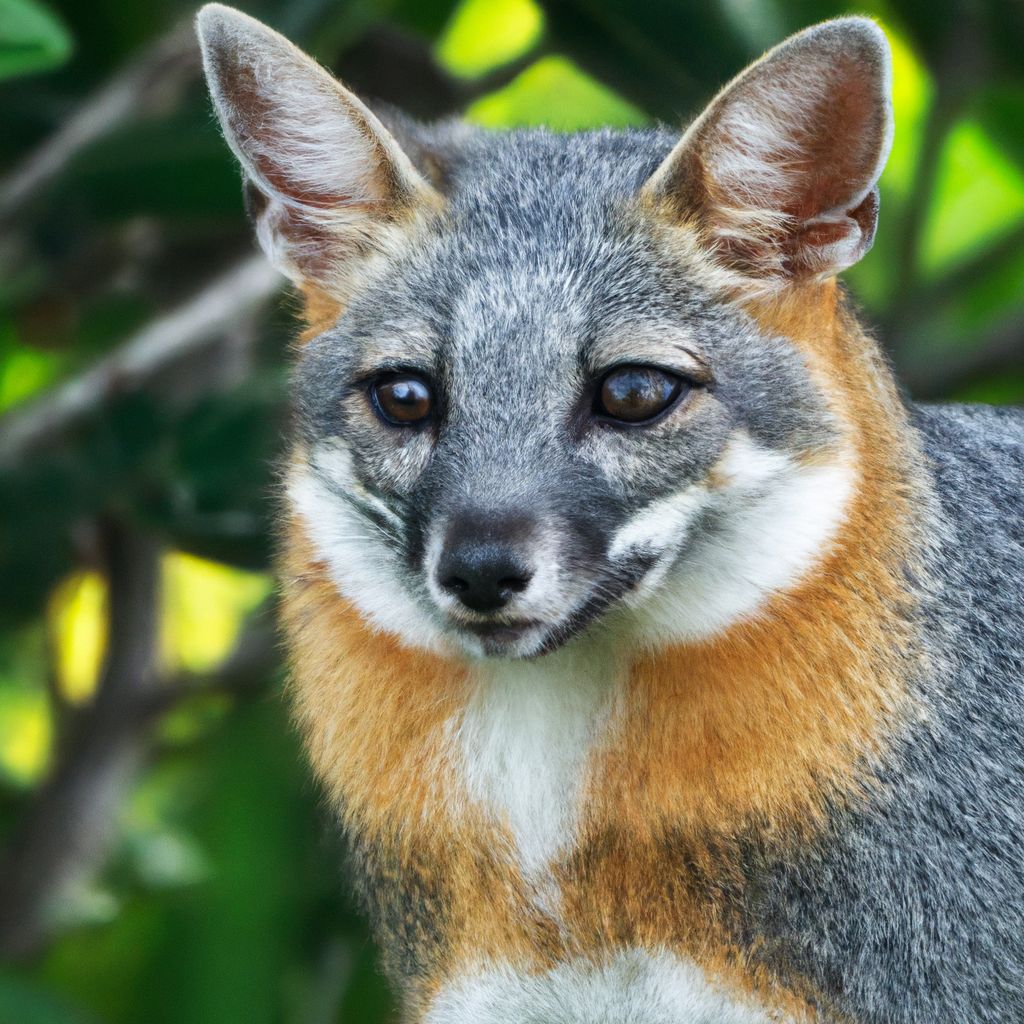The Gray Fox, also known as Urocyon cinereoargenteus, is a fascinating species that inhabits certain regions of North and Central America. Understanding its reproduction and life cycle is crucial for gaining insights into the biology and ecology of this elusive creature. To delve deeper into the world of the Gray Fox, this article provides a comprehensive examination of its reproductive behavior and life stages. We will explore the mating season, courtship behavior, gestation period, birth of kits, and the developmental milestones of these young foxes. we will dive into the different phases of the Gray Fox’s life cycle, including early life, adolescence, adulthood, and senescence. While the Gray Fox faces various challenges and threats to its reproduction and life cycle, such as habitat loss, predation, and disease, conservation and management efforts have been implemented to protect and conserve this species. These include initiatives focused on habitat conservation, control of invasive species, and research and monitoring programs. For a detailed look at its relationship with humans, you can visit the Gray Fox Authority website. By delving into the reproduction and life cycle of the Gray Fox, we can gain a deeper appreciation for this magnificent species and work towards ensuring its continued survival and well-being.
Contents
- 1 Key takeaway:
- 2 Physical Characteristics of the Gray Fox
- 3 Habitat and Distribution of the Gray Fox
- 4 The Reproduction of Gray Foxes
- 5 The Life Cycle of Gray Foxes
- 6 Challenges and Threats to Gray Fox Reproduction and Life Cycle
- 7 Conservation and Management Efforts for Gray Foxes
- 8 Frequently Asked Questions
- 8.1 What are the physical characteristics of the Gray Fox?
- 8.2 Where can the Gray Fox be found?
- 8.3 What is the diet of the Gray Fox?
- 8.4 How does the Gray Fox reproduce and care for their young?
- 8.5 What is the behavior and habitat of the Gray Fox?
- 8.6 What are the conservation status and threats to the Gray Fox?
Key takeaway:
- Gray fox reproduction maximizes care: Gray foxes exhibit unique courtship behaviors during mating season and provide parental care to their kits, ensuring their survival and development.
- Gray foxes adapt to various habitats: Gray foxes have a wide distribution and can thrive in different habitats, making them resilient to environmental changes.
- Conservation efforts are crucial for gray foxes: Habitat loss, predation, competition, diseases, and parasites pose significant threats to gray fox reproduction and life cycle, making conservation and management programs essential for their survival.
Physical Characteristics of the Gray Fox
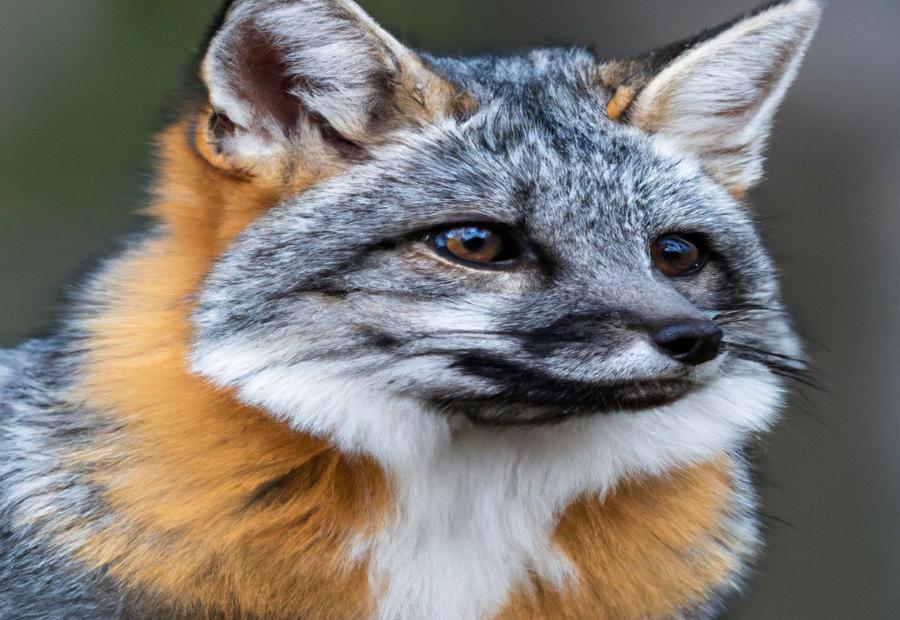
Photo Credits: Foxauthority.Com by Albert Nelson
The gray fox has distinct and unique physical characteristics that allow it to adapt and thrive in different environments. The size of the gray fox is medium-sized, measuring 32-47 inches long, including its tail. It stands 12 to 16 inches tall at the shoulder. Its fur is mostly gray with a reddish tinge, giving it the name “gray fox.” The fur on its face and throat is usually whitish or light gray. It has a dense undercoat for insulation. The gray fox has large, pointed ears that help it hear even the smallest sounds. One of the gray fox’s most distinctive features is its bushy tail, which can be as long as its body. The tail aids in balancing while climbing trees and serves as a signaling mechanism during social interactions. Unlike other fox species, the gray fox can retract its claws, making tree climbing effortless. This adaptation gives it an advantage when seeking refuge or searching for food. The gray fox is an omnivorous mammal that consumes small mammals, birds, insects, fruits, and nuts. This adaptable diet helps it survive in various habitats. Pro-tip: When encountering a gray fox, observe from a distance to avoid disrupting its natural behavior. Appreciate its beauty and adaptability from a respectful distance.
Habitat and Distribution of the Gray Fox
The habitat and distribution of the gray fox are influenced by factors like food availability, climate, and suitable cover. This species is commonly found in forests, woodlands, and brushy areas throughout North and Central America. It is remarkably adaptable and can thrive in various environments, including densely vegetated regions and open grasslands, making it well-suited for both rural and urban areas. The gray fox’s range spans from southern Canada to South America. While it is more abundant in the southern parts of its range, particularly in the southwestern United States and Mexico, it can also be found in the northeastern United States, the Great Plains, and parts of Central America. This solitary animal establishes territories for hunting and breeding, and it is primarily active at night. Thanks to its excellent climbing abilities, it can navigate different terrains and seek shelter in trees or dens. Dens can be located in hollow trees, brush piles, or underground burrows. As for its diet, the gray fox is highly adaptable and consumes a wide range of food, including small mammals, birds, fruits, and insects. If you want to attract gray foxes to your backyard, consider creating wildlife-friendly habitats. Providing cover such as bushes, shrubs, and trees is essential, and it’s important to avoid harmful pesticides. Additionally, leaving fallen logs or brush piles can offer potential den sites. Remember to observe these agile and resourceful animals from a distance, as they play a crucial role in maintaining the balance of the ecosystem.
The Reproduction of Gray Foxes
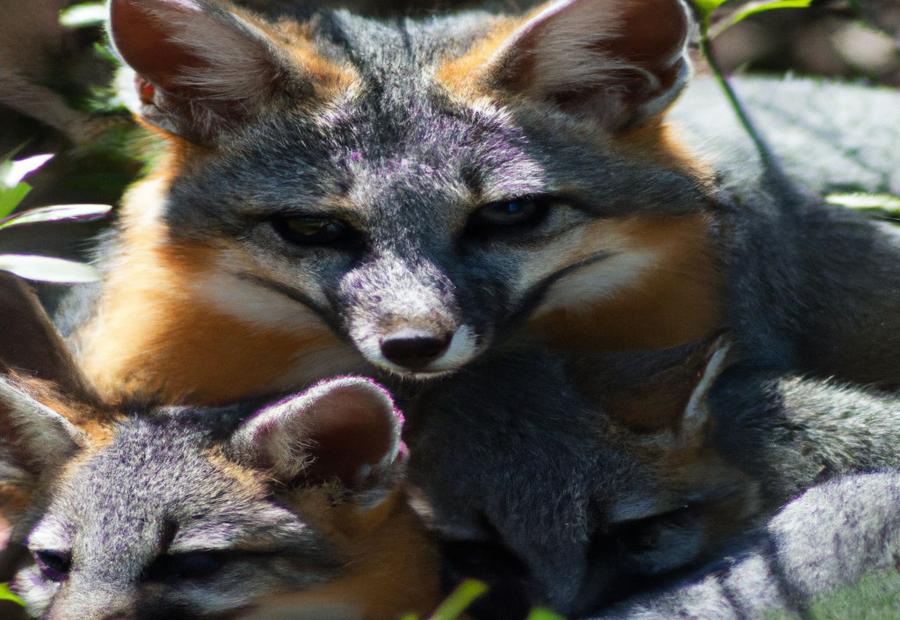
Photo Credits: Foxauthority.Com by Patrick Nelson
Get ready to dive into the fascinating world of gray fox reproduction! In this section, we’ll explore the various aspects of their reproductive cycle, from their intriguing mating season and courtship behavior to the remarkable gestation period and birth of their adorable kits. We’ll also take a closer look at the development and dependency of these kits, shedding light on the unique characteristics that make gray foxes such intriguing creatures. So, buckle up and let’s unravel the mysteries of gray fox reproduction together!
Mating Season and Courtship Behavior
Gray foxes engage in courtship behavior during the mating season to attract a mate. Males and females communicate through vocalizations like barks, screams, and howls to locate and identify potential partners. Once a suitable mate is found, courtship rituals begin. The male approaches the female cautiously, sniffing her scent markings to determine receptiveness. If the female is interested, she may crouch down and flick her tail in invitation. To strengthen their bond, the pair engages in mutual grooming, licking each other’s fur and nuzzling. This grooming behavior reinforces their connection and removes debris or parasites from their fur. During mating, the male mounts the female from behind. Copulation is brief, lasting only a few minutes. After mating, the pair may stay together briefly or go their separate ways. It’s important to note that not all courtship attempts are successful, as females may reject advances from males they are not interested in. Additionally, dominant males aggressively exclude other males from approaching females in their territory. Fact: The mating season for gray foxes typically occurs from January to March. During this time, the calls of mating foxes can often be heard echoing through the forest, signaling the start of the reproductive season.
Gestation Period and Birth of Kits
The gestation period and birth of kits are vital components of the reproduction and life cycle of gray foxes. Female gray foxes typically experience an average gestation period of around 53 days. These intelligent creatures carefully select a den in a secluded area, such as a hollow tree or dense vegetation, to provide a safe space for their kits. Once the gestation period comes to an end, female gray foxes give birth to an average of four to six kits, although larger litters containing up to ten kits have been observed. These newborn kits enter the world blind and deaf, relying entirely on their mother for warmth, protection, and nourishment. During the first few weeks, the mother gray fox dutifully nurses her kits, ensuring they receive the vital nutrients necessary for their growth. As the kits mature, their eyes and ears gradually open, enabling them to explore their surroundings and interact with their siblings. During this crucial stage of life, the kits form strong bonds with both their mother and siblings, fostering vital social connections within the family unit. The mother plays a pivotal role in teaching her young valuable survival skills, including hunting and finding adequate shelter, which ultimately contribute to their overall development. A deeper understanding of the gestation period and birth of kits offers valuable insights into the reproduction and life cycle of gray foxes. It serves to emphasize the significance of maternal care and early developmental stages. By actively safeguarding their habitats and promoting conservation efforts, we can ensure the continued reproduction and sustainable population of these remarkable animals. Embark on a fascinating journey into the world of gray foxes, and expand your knowledge about the various factors impacting their reproduction and life cycle. By doing so, you actively contribute to the protection and conservation of their habitats, ensuring that future generations can appreciate and cherish these magnificent creatures.
Development and Dependency of Kits
The development and dependency of kits are essential aspects to comprehend in the life cycle of the gray fox. Here are key points to understand: 1. Early stages: After a gestation period of about 51-53 days, the female gray fox gives birth to a litter of 3-7 kits. 2. Dependency on mother: The kits are born blind, helpless, and rely entirely on their mother for warmth, milk, and protection. To understand more about the unique adaptations and survival tactics of the Gray Fox, click here. 3. Rapid growth: The kits rapidly develop. Within the first two weeks, their eyes open, and they begin to explore their den under their mother’s watchful eye. 4. Development of skills: As the kits grow, they start developing motor skills and coordination by practicing pouncing, stalking, and play-fighting. These activities hone their hunting abilities. 5. Weaning process: At around 6-8 weeks old, the kits start transitioning from their mother’s milk to a solid food diet. This gradual process prepares them for independence. 6. Family dynamics: The father plays an important role by providing food and protecting the den. The kits learn from both parents, acquiring essential survival skills. The Gray Fox’s Role in Ecosystem Balance 7. Independence: By 4-5 months of age, the kits become more independent and accompany their parents on foraging trips. They continue refining their hunting skills under parental guidance. 8. Dispersal: Around 7-9 months old, the kits disperse from their family group to establish their own territories. Understanding the development and dependency of kits is crucial for comprehending the gray fox’s life cycle and their journey to becoming self-sufficient adults. Studying these fascinating creatures provides valuable insights into the natural world and contributes to conservation efforts.
The Life Cycle of Gray Foxes
The life cycle of gray foxes takes us on a fascinating journey from early life to senescence. We’ll discover the world of gray fox kits, their upbringing and parental care. Then, we’ll delve into the exciting stage of adolescence, where learning and exploration shape their future. As they transition into adulthood, we’ll witness their efforts in establishing territories and the wonders of reproduction. Finally, we’ll explore the implications of senescence on the survival of these remarkable creatures. Get ready to unravel the captivating life cycle of gray foxes!
Early Life: Kits and Parental Care
During the early life of gray foxes, the kits rely on their parents for care and support. Kits, which refers to the offspring of gray foxes, play a vital role in their upbringing. Here are the stages and activities involved in their early life and the parental care they receive:
- Birth: The mother gray fox gives birth to a litter of kits, usually ranging from one to seven individuals.
- Nursing: During the first few weeks of their lives, the kits depend on their mother’s milk for nourishment.
- Development: As the kits grow, their senses and physical abilities start to develop. They open their eyes and explore their surroundings.
- Parental Bond: Both the mother and father fox play important roles in raising the kits. The parents provide warmth, protection, and guidance.
- Feeding: Alongside nursing, the kits gradually transition to consuming solid food. Their parents bring prey to the den for the kits to eat.
- Exploration: With the watchful eyes of their parents, the kits become more mobile and venture out of the den. They engage in playful activities, practice hunting skills, and interact with their littermates.
- Socialization: Interacting with their siblings and parents helps kits learn essential social skills and behaviors necessary for survival within their family unit.
- Learning: Kits closely observe and imitate their parents’ hunting techniques, communication signals, and territorial behaviors, gradually gaining proficiency in these crucial skills.
- Independence: Around the age of four to six months, gray fox kits start becoming more independent. They explore territories beyond their birth den and prepare for adolescence.
These stages in the early life of gray fox kits, accompanied by the dedicated parental care, are crucial for their development and preparedness to face the challenges they encounter as they grow.
Adolescence: Learning and Exploring
Adolescence is a pivotal period for gray foxes as they engage in learning and exploration to prepare for adulthood. During this phase, they actively seek out new experiences and information, acquiring essential survival skills such as hunting, recognizing threats, and navigating their environment. Through trial and error, they cultivate the necessary abilities to become self-sufficient individuals. Gray foxes also embark on exploratory journeys during adolescence, venturing beyond their natal territories to expand their understanding of the landscape and discover untapped resources. This exploration not only aids in the establishment of their own territories later in life but also heightens their chances of finding suitable mating partners and securing necessary resources. In addition to their physical exploration, gray foxes form social bonds with fellow adolescents during this stage. These social interactions play a crucial role in shaping their future interactions as adults. They provide valuable opportunities for learning and sharing knowledge about the environment. Fun Fact: Among canids, gray foxes possess a distinct climbing ability. They are proficient at scaling trees and navigating various levels of their habitat using their hooked claws. This adaptation enables them to elude predators and access resources that are out of reach for ground-dwelling predators. For more information on the seasonal behavior and migration patterns of the gray fox, you can refer to The Gray Fox: A 2023 Guide to Its Seasonal Behavior and Migration Patterns.
##Link Title: The Gray Fox: A Closer Look at Its Reproduction and Life Cycle
##Link Keyword: The Gray Fox: A Comprehensive Study of Its Physiology and Health
##Link: Visit here for a comprehensive study of the gray fox’s physiology and health. \
Adulthood: Territory Establishment and Reproduction
Adulthood is a crucial phase for gray foxes as they go through territory establishment and reproduction. During this stage, adult gray foxes mark and defend territories, which can range from 1 to 3 square miles. This ensures their access to important resources like food, shelter, and potential mates. Mating typically takes place in late winter to early spring, where male foxes compete for females through courtship behavior. After successful mating, females undergo a gestation period of about 53 days and give birth to a litter of 2 to 7 kits. The females play a vital role in caring for and nurturing the kits until they are capable of exploring and learning survival skills on their own. Adult gray foxes dedicate significant time and effort to raising their offspring, teaching them essential hunting techniques, and introducing them to their assigned territory. Understanding the dynamics of adulthood is crucial for ensuring the growth and stability of the gray fox population and maintaining their overall vitality in their natural habitats.
Senescence: Aging and Implications on Survival
Senescence, the natural aging process, has significant implications on the survival of gray foxes. As these foxes grow older, they face various challenges that can greatly impact their well-being and chances of survival. One of the key effects of senescence is the decreased physical capabilities of gray foxes. With age, these foxes experience a decline in strength, agility, and speed, making them more vulnerable to predation. Additionally, their reduced physical abilities hinder their effectiveness at capturing prey. Senescence also affects the reproductive success of gray foxes. Older individuals may have lower fertility and may struggle to find mates, ultimately reducing their chances of successful reproduction and passing on their genes. Another consequence of senescence is the increased susceptibility to diseases. As foxes age, their immune systems weaken, making them more prone to diseases and infections. This compromises their overall health and increases their mortality rates. Older gray foxes also face increased competition for limited resources such as food, water, and shelter. Younger individuals may outcompete them, making it challenging for older foxes to secure sufficient resources for survival. Furthermore, aging foxes become easier targets for predators due to their declining agility and ability to escape. This puts them at a higher risk of predation, further impacting their chances of survival. Senescence also limits the reproductive opportunities for gray foxes. In the wild, gray foxes typically live for 6-8 years, and as they age, the window for reproductive opportunities narrows, reducing their chances of contributing to the next generation.
Challenges and Threats to Gray Fox Reproduction and Life Cycle
Challenges abound for the gray fox when it comes to reproduction and its overall life cycle. From habitat loss and fragmentation to predation and competition, as well as the constant threat of disease and parasites, the survival of these cunning creatures is far from assured. Delve into the perilous world of the gray fox as we explore the threats they face and the impact it has on their ability to thrive and reproduce.
Habitat Loss and Fragmentation
Habitat loss and fragmentation have a detrimental impact on populations of gray foxes. The conversion of natural habitats into urban areas, agricultural lands, and roads caused by human development destroys the habitat of the foxes. The loss of habitat greatly restricts the gray foxes’ ability to find suitable areas, food, and raise their young. Fragmentation separates populations, making it more difficult for them to find mates and maintain genetic diversity. These circumstances can result in decreased reproductive success and increased susceptibility to genetic disorders and diseases. For a detailed examination of its social behavior, you can visit the website here. The natural connectivity and movement patterns of gray foxes are disrupted by habitat loss and fragmentation. They depend on connected landscapes to travel, establish territories, and expand their range. Fragmentation amplifies isolation and intensifies the impacts of threats such as predation and disease. Efforts in conservation should aim to mitigate habitat loss and fragmentation. This involves safeguarding and restoring habitats, creating wildlife corridors to connect fragmented areas, and promoting sustainable land-use practices that prioritize natural habitats. By supporting local conservation organizations and advocating for responsible urban development, we can minimize habitat loss and fragmentation, thus ensuring the long-term survival of gray fox populations.
Predation and Competition
Predation and competition play a significant role in the survival and reproductive success of gray foxes. These foxes face a wide range of predators, including coyotes, bobcats, mountain lions, and larger birds of prey. The constant presence of these predators poses a continuous threat, especially to young kits. The population of gray foxes in the ecosystem is regulated by predation. In addition to predation, gray foxes also experience competition from raccoons and coyotes. These species compete for similar food sources such as small mammals, birds, and insects. The limited availability of food due to this competition can directly impact the growth and reproduction of gray foxes. The reproductive behavior of gray foxes can be influenced by predation. Female foxes may choose to delay mating or seek out safer areas for their dens to protect their offspring from predators. Competition for territory and resources can also restrict suitable habitats, thus affecting breeding success. For a 2023 update on the population and distribution of the gray fox, you can visit this website. A thorough understanding of predation and competition is crucial for the conservation and management of gray fox populations. It is important to minimize habitat loss and fragmentation in order to provide secure environments that reduce predation risks. Additionally, managing invasive species, which contribute to increased competition for resources, is vital for maintaining healthy gray fox populations.
Disease and Parasites
Disease and parasites greatly impact the health and survival of gray foxes. Disease and parasites can harm the population and disrupt the foxes’ life cycle. 1. Infectious diseases: Gray foxes are susceptible to diseases like rabies. Rabies, caused by a viral infection, can be fatal for both animals and humans. Vaccination programs are crucial to prevent the transmission of diseases like rabies between wildlife and domestic animals. 2. Parasitic infestations: Gray foxes can suffer from external and internal parasites. Ticks, fleas, and mites can cause discomfort and transmit diseases. Worms can affect their digestive system and overall health. Regular deworming and preventive measures against external parasites are essential for the well-being of gray foxes. 3. Transmission from other animals: Gray foxes can contract diseases and parasites from other animals. For example, they may get fleas or ticks from interacting with small mammals or other wildlife. Managing habitats and reducing situations where different animal species come into close proximity can minimize the risk of disease transmission. 4. Impact on reproduction and life cycle: Disease and parasites can negatively affect gray fox reproduction. If a female fox is infected during pregnancy, it can lead to complications and death of the unborn kits. Disease outbreaks can also reduce the survival rates of young foxes, potentially impacting the overall population. Awareness and understanding of the diseases and parasites affecting gray foxes are crucial for conservation efforts. Implementing measures like proper waste management and regular veterinary care can help safeguard the health and well-being of these fascinating creatures.
Conservation and Management Efforts for Gray Foxes
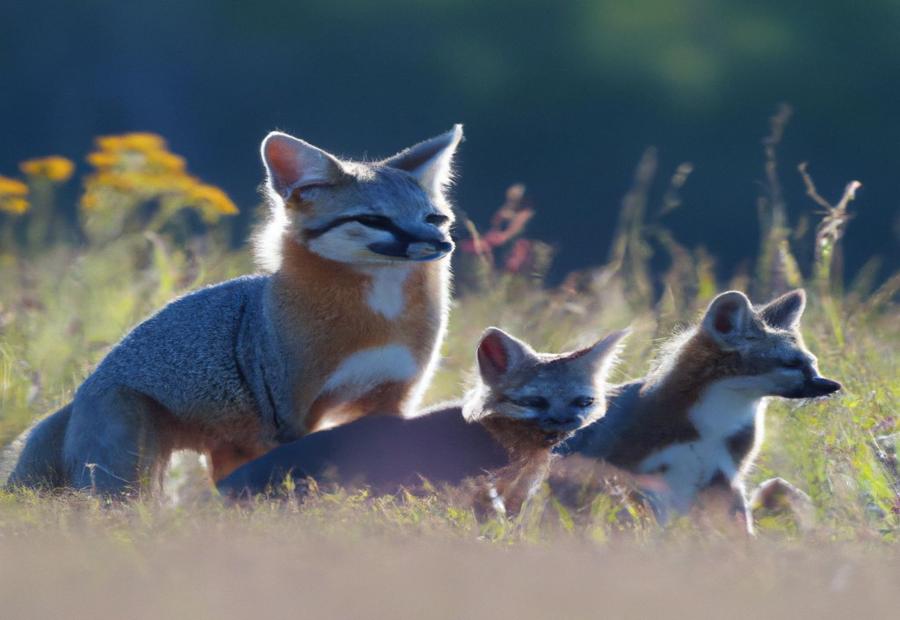
Photo Credits: Foxauthority.Com by Kevin Sanchez
Conservation and management efforts for gray foxes are crucial for ensuring the survival and well-being of this remarkable species. By focusing on habitat conservation and restoration, control of invasive species, and implementing rigorous research and monitoring programs, we can effectively protect the gray fox population. These efforts play a vital role in maintaining the delicate balance of the ecosystem and safeguarding the future of these beautiful creatures. Let’s take a closer look at these important sub-sections and the impact they have on gray fox conservation.
Habitat Conservation and Restoration
Habitat conservation and restoration play a vital role in safeguarding the survival and well-being of the gray fox population. It is crucial to protect and restore their natural habitats to ensure their continued existence. Habitat conservation is of utmost importance in protecting the gray fox. This entails preserving their habitats from encroachment caused by human activities like urbanization and deforestation. By safeguarding their habitats, we can provide the necessary resources for the gray fox population’s well-being. The restoration of degraded habitats is also a critical aspect of conserving the gray fox. This involves activities such as reforestation, creating wildlife corridors, and removing invasive species that impact their habitat negatively. These efforts aim to establish a suitable environment where the gray fox population can thrive. To achieve successful habitat conservation and restoration, it is essential to engage in partnerships with local communities, conservation organizations, and government agencies. These collaborations allow for coordinated efforts and the sharing of resources, maximizing effectiveness in preserving gray fox habitats. Continual research and monitoring of the gray fox population and their habitats are crucial for effective conservation efforts. It is vital to study their behavior, population dynamics, and habitat requirements to inform conservation strategies and ensure their long-term survival. Raising awareness about the importance of habitat conservation and restoration for gray foxes is vital. Educating the public about the ecological role of gray foxes and the benefits of preserving their habitats can garner support and encourage actions that contribute to their conservation efforts. By prioritizing habitat conservation and restoration, we can play a pivotal role in ensuring the future survival of the gray fox population. Protecting their habitats, restoring degraded areas, promoting research and monitoring, and raising public awareness are all essential steps in safeguarding these incredible animals for future generations.
Control of Invasive Species
Controlling invasive species is of utmost importance in the conservation and management of gray fox populations. To achieve this, it is essential to implement targeted eradication efforts, enforce strict regulations, and establish monitoring systems to prevent introductions. Furthermore, restoring native habitats, raising public awareness through education, and conducting regular monitoring and research are key measures to effectively control invasive species. By implementing these measures, we can safeguard the reproductive success and life cycle of gray foxes.
Research and Monitoring Programs
Research and monitoring programs play a crucial role in the understanding and conservation of the gray fox population. These programs collect valuable data on the reproductive behavior and life cycle of gray foxes, covering important aspects such as data collection, behavioral studies, reproduction monitoring, evaluation of survival rates, and conservation planning. Through these research and monitoring programs, we gain a deeper understanding of gray foxes and work towards their conservation and long-term survival.
Frequently Asked Questions
What are the physical characteristics of the Gray Fox?
The Gray Fox is a medium-sized mammal with a grizzled gray coat, blackish bands on the muzzle, and a black-tipped tail. It has coarser fur, shorter legs, and a shorter muzzle compared to other fox species. It also has dark brown eyes and a mane of stiff, black hairs on the dorsal surface of the tail.
Where can the Gray Fox be found?
The Gray Fox has a wide range, from the northern tip of South America to the extreme southern portions of eastern Canada, and to the Great Basin and northern Rocky Mountains in the western United States. It is a relatively common resident of the Adirondack Park, occurring up to elevations of at least 915 m. It prefers deciduous forests and brushy, rocky woodlands, but can also be found in mixed forests and forest-farmland edges.
What is the diet of the Gray Fox?
The Gray Fox is an opportunistic omnivore and has a varied diet. It primarily feeds on small to medium-sized mammals, birds and their eggs, large seeds, fruits, insects, reptiles, and amphibians. Cottontails, mice, and voles are its major prey items. Unlike the red fox, the gray fox consumes a greater amount of fruit and birds.
How does the Gray Fox reproduce and care for their young?
Breeding season for Gray Foxes is from late January to May, with the peak in March. The gestation period is 51-63 days, and the female gives birth to a litter of 2-7 pups. The young are blind at birth and weigh approximately 86g. They open their eyes at 9-12 days old. Both adults care for the young by bringing food and guarding the den. At around 12 weeks old, the pups are weaned and join the adults on hunting trips.
What is the behavior and habitat of the Gray Fox?
The Gray Fox is active throughout the year and primarily forages at twilight or night but may also hunt during the day. It travels by walking or trotting, but can gallop or run when necessary, reaching speeds of 32.2-45.1 km/h. Unlike the red fox, it can climb trees by leaping into branches near the ground and using its back legs to power the climb. It may also leap or hop from one branch to another and descend by running or backing down the trunk head first. The gray fox may rest in the open or in dens located in abandoned burrows or hollow logs, trees, brush piles, and rocks.
What are the conservation status and threats to the Gray Fox?
The Gray Fox is currently classified as Least Concern on the IUCN Red List, and its numbers remain stable. The main threats to the species include habitat loss, degradation, and fragmentation due to human activities. They are also illegally sold as pets in some areas. Hunting and trapping can help regulate fox populations and provide recreational opportunities, but they are susceptible to predation by feral dogs and coyotes.
